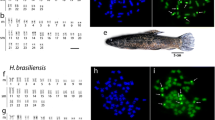Abstract
A karyotype analysis by several staining techniques was carried out on the great sturgeon, Huso huso (Linnaeus, 1758). The karyotype (2n = 118 ± 2) was composed of 42 pairs of meta-/submetacentric chromosomes and 17 pairs of acrocentrics/microchromosomes. Constitutive heterochromatin was mainly located at the centromeric regions of the acrocentric chromosomes. The biarmed chromosomes showed weak C-bands. Fluorescent staining with GC-specific chromomycin A3 showed clearly recognizable fluorescent regions, whereas a more uniform base composition was revealed by the AT-specific 4,6-diamidino-2 phenylindole. After Ag-staining, nucleolar organizer regions could be observed on the short arms of two medium-sized submetacentrics and on two acrocentrics. Digoxigenated 28S and 5S rDNA probes, prepared from Acipenser naccarii DNA and hybridized to metaphase chromosomes, showed signals on six and two chromosomes, respectively. The telomeric sequence (TTAGGG) n detected by FISH was located at both ends of each chromosome. Results are discussed in relation to karyotype organization and evolution in sturgeons.
Similar content being viewed by others
Author information
Authors and Affiliations
Additional information
Received: 1 April 1998 / Accepted: 21 July 1998
Rights and permissions
About this article
Cite this article
Fontana, F., Tagliavini, J., Congiu, L. et al. Karyotypic characterization of the great sturgeon, Huso huso, by multiple staining techniques and fluorescent in situ hybridization. Marine Biology 132, 495–501 (1998). https://doi.org/10.1007/s002270050415
Issue Date:
DOI: https://doi.org/10.1007/s002270050415




